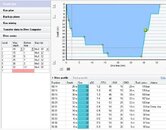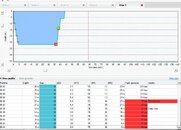Hi Mark: thanks for the question. Ironically, my editor and I are working through the gas toxicity chapter of my new book! I could do a quick cut and paste but that might make me unpopular. LOL
Anyhow, I would suggest some reading. This entry is not bad
Oxygen toxicity - Wikipedia, the free encyclopedia and I believe I may have contributed a couple of paragraphs but you might also order TDI's Nitrox book. I co-authored that one and unless it's been radically changed, should cover much of what seems to be confusing you.
In simplest terms, there are TWO types of oxygen toxicity that we need to be aware of. The PAUL BERT effect which interacts with the central nervous system (CNS toxicity) and the Lorrain Smith effect which is a pulmonary condition and which is NOT historically of much concern for divers.
CNS toxicity is managed by tracing DOSE.... that's to say, oxygen depth over allowable time. I have posted links to and copied and pasted NOAAs CNS table in this thread already. To track CNS exposure, we must know the partial pressure of oxygen delivered by our mix at depth and the time we spend breathing it. The partial pressure of oxygen is determined by the total pressure at depth (for instance 30 metres is 4 bar) and we multiply that by the fraction of oxygen in our mix, let's say we have an EAN35. 4 X 0.35 = 1.4 bar... this is our oxygen pressure. The NOAA single dive limit for that partial pressure is 150 minutes. If our bottomtime were 50 minutes, we will have used about one-third of our allowable oxygen time and the CNS "clock" will be at about 34%. NOAA tables also contain 24-hour CNS limits. The potential outcome of being sloppy with CNS toxicity is convulsion and that usually results in death by embolism, drowning or heart attack.
Pulmonary toxicity is NOT THE SAME. Simply put, it is not a factor for this sort of dive, or really for any sort of recreational dive and it is not worth the bother of tracking except in extreme technical dives. Although severe cases of pulmonary toxicity cause true health concerns , the potential outcome of pulmonary toxicity for a diver is a sore throat and shortness of breath... SEVERAL ORDERS OF MAGNITUDE LESS OF A CONCERN.
OTUs are used to track pulmonary toxicity and have NOTHING TO DO WITH CNS.
Oxygen toxicity can also effect vision, but forget that for the time-being.







